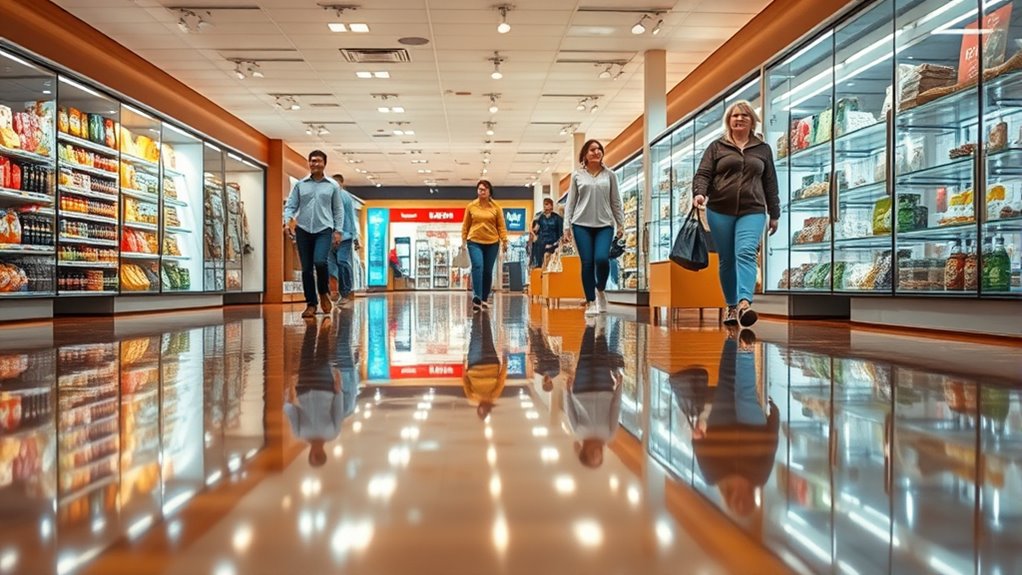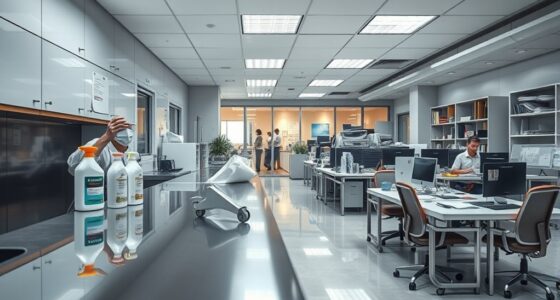Keeping your store floors shiny and well-maintained is key to creating a welcoming environment that builds customer trust and confidence. Regular cleaning schedules prevent dirt and spills from accumulating, while proper tools and safety protocols ensure a hazard-free space. Preventive maintenance helps catch issues early, saving you money in the long run. Prioritizing safety and cleanliness not only improves your store’s appearance but also encourages customers to return—discover more tips to keep floors spotless and shoppers satisfied.
Key Takeaways
- Consistent cleaning schedules keep floors shiny, enhancing store appearance and customer satisfaction.
- Proper safety protocols prevent slips and falls, ensuring a safe shopping environment.
- Using appropriate tools and products preserves floor quality and promotes a polished look.
- Preventive maintenance detects and repairs damage early, extending flooring lifespan and safety.
- A culture of safety and cleanliness builds customer trust and encourages repeat visits.

Have you ever wondered how stores keep their floors looking spotless and safe for customers? It all comes down to a well-planned approach to floor maintenance, which relies heavily on consistent cleaning schedules and strict safety protocols. When you prioritize regular cleaning, you ensure that dirt, spills, and debris don’t accumulate, reducing the risk of slips and falls. Establishing a cleaning schedule means your store’s floors are cleaned at specific times each day, whether during off-peak hours or after closing. This predictability helps staff stay organized and ensures no area gets overlooked. It’s not just about cleanliness; it’s about safety, too. Safety protocols involve training staff to identify hazards, use appropriate cleaning agents, and follow procedures that prevent accidents. For example, using warning signs when mopping or wet floors alerts customers and employees to potential hazards, preventing slips.
Consistent cleaning and safety protocols keep store floors spotless and safe for everyone.
Maintaining floors also involves choosing the right cleaning tools and products. For high-traffic areas, you might need industrial-grade equipment that can handle frequent cleaning without damaging the surface. Using the correct cleaning solutions ensures dirt and grime are effectively removed without compromising the floor’s finish or safety. Regularly inspecting floors for damage or wear is another critical part of your routine. Small cracks or chips can become safety issues if ignored. Repairing these promptly not only extends the lifespan of your flooring but also keeps the environment safe for everyone in your store. Incorporating preventive maintenance strategies can help catch issues early before they escalate into bigger safety hazards.
Implementing safety protocols goes beyond just cleaning. It includes training your staff on how to handle spills immediately, use warning signs properly, and communicate hazards to customers. For example, if a spill occurs, quick action prevents accidents and demonstrates that safety is a priority. Additionally, keeping floors dry and free from obstacles helps maintain a secure shopping environment. When your team adheres to these protocols consistently, it creates a culture of safety that customers notice and appreciate.
In essence, a successful floor maintenance program combines a reliable cleaning schedule with diligent safety protocols. These practices keep floors shiny and inviting while also protecting everyone who steps inside. It’s a continuous effort—regular cleaning, prompt repairs, staff training, and safety awareness all work together to create a store environment that feels clean, professional, and secure. When you prioritize these elements, you not only enhance the appearance of your store but also build trust with your customers, who feel confident shopping in a safe, well-maintained space.
Frequently Asked Questions
How Often Should Store Floors Be Professionally Inspected?
You should establish a regular floor inspection schedule based on your store’s traffic and usage. Typically, professional inspections are recommended every 3 to 6 months, but high-traffic areas may require more frequent checks. This maintenance frequency helps identify issues early, preventing costly repairs and ensuring safety. By adhering to a consistent inspection schedule, you keep your floors in top condition, creating a welcoming environment for customers and staff alike.
What Eco-Friendly Cleaning Products Are Best for Store Floors?
You might think eco-friendly solutions are too mild for store floors, but they’re surprisingly effective. For sustainable cleaning, opt for products made from natural ingredients like vinegar, baking soda, or plant-based enzymes. These eco-friendly cleaning options clean thoroughly without harsh chemicals, protecting your environment and your customers’ health. Choosing eco-friendly solutions isn’t just trendy—it’s smart, ensuring your store stays spotless and eco-conscious at the same time.
How Can Slip Hazards Be Minimized During Maintenance?
To minimize slip hazards during maintenance, you should focus on slip prevention by promptly cleaning up spills and using absorbent mats. Always place safety signage around wet or slippery areas to alert customers and staff. Ensuring proper drying time and using slip-resistant cleaning products further reduces risks. Regular training helps staff recognize potential hazards, creating a safer environment. These steps protect everyone and maintain a secure shopping space.
What Are the Costs Associated With Different Floor Maintenance Methods?
Think of floor maintenance methods as different roads you can take—each with its own toll. A cost comparison shows that regular, basic cleaning might be light on your budget, but frequent deep treatments add up. You’ll want to balance maintenance frequency with expenses, choosing a method that keeps floors gleaming without draining resources. Ultimately, smart choices keep your store safe, appealing, and cost-effective in the long run.
How Does Floor Maintenance Impact Store Customer Foot Traffic?
You notice how well-maintained floors can boost your store’s foot traffic by enhancing floor aesthetics. When your floors look clean and shiny, customers perceive your store as more inviting and professional, encouraging them to stay longer and return. Good floor maintenance directly impacts customer perception, making your store stand out positively. By prioritizing regular cleaning and upkeep, you create an environment that attracts more shoppers and fosters a welcoming shopping experience.
Conclusion
Maintaining your floors might seem minor, but it truly transforms your store’s look and lifts customer loyalty. Clean, coated, and cared-for floors create a mesmerizing, consistent charm that customers can’t resist. Don’t delay diligent detailing—delight in dazzling, durable floors that draw in diverse shoppers daily. Prioritize proper polishing and proactive preservation to produce pristine premises that promise pleasant purchasing experiences. Remember, happy customers happily return, and shiny floors are your first step to success!










